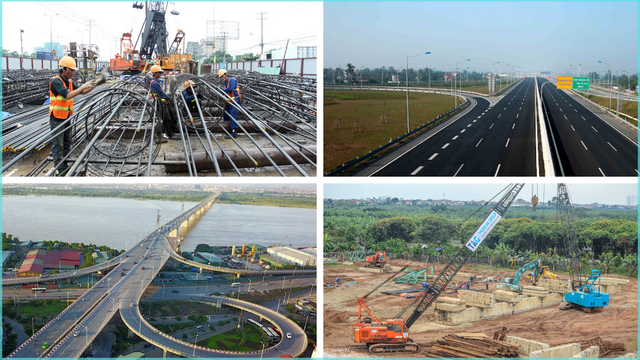
During the first 3 months of the year, 6 provinces that are under the responsibility of the inspection and supervision of Task Force No. 5 have basically achieved a lower disbursement rate of 2024 public investment capital than the average rate of the whole country. Specifically, Binh Thuan reached 8.77%; Gia Lai reached 6.31%; Dong Nai reached 10.59%; Binh Duong reached 11.98%; Binh Phuoc reached 10.7%; and Tay Ninh reached 13.6%.
The estimated possible disbursement for 4 months of these 6 provinces also does not show much progress. Specifically, Binh Thuan 12.88%; Gia Lai 11.37%; Dong Nai 18.43%; Binh Duong 16.79%; Binh Phuoc 16.36% and Tay Ninh 18.18%.
Obstacles in the mechanisms, policies and implementation organization
The report from the Ministry of Finance shows that the reason for the low disbursement of public investment (PI) capital as stated by the 6 localities is due to numerous limitations in the mechanisms and policies, as well as in the implementation organization.
Specifically, Gia Lai province is facing difficulties in determining land prices. According to the province, the determination of land prices has many limitations, which has affected many projects relating to site clearance and compensation (SCC), as well as the handover of clear sites to construction units. Therefore, this locality has proposed that the Government soon issue a Decree to amend and supplement Decree No. 44/2014/ND-CP regulating the method for determining land prices, ensuring that when authorized, they are reasonable.
Binh Duong province is currently implementing a number of projects of an inter-regional nature. However, the Law on Public Investment has not yet stipulated the order of procedures and authorities for PI projects in the areas of two or more provincial-level administrative units.
Meanwhile, the National Assembly has issued Resolution No. 106/2023/QH15 piloting a number of specific policies on investment in the construction of road works, which includes piloting the policy whereby a provincial-level People’s Committee is allowed to act as the competent authority, and is permitted to use the local budget of this locality to support other localities in implementing PI activities for projects across localities for those projects that are specified in this Resolution.
However, the projects that Binh Duong province is implementing are not included in this regulation. Therefore, the investment in the construction of projects in the areas of two provinces from PI capital sources does not have a strict legal basis. Accordingly, Binh Duong province has proposed that relevant ministries and agencies soon provide instructions on investment in projects in the areas of two provincial-level administrative units in addition to the projects under Resolution No. 106/2023/QH15 of the National Assembly…
Proposal for early detailed allocation of capital
According to the Ministry of Finance, as of the end of March 2024, in these 6 localities, there are still many projects that have been allocated capital plans that have not yet been disbursed or have very low disbursement rates (below 5% of the 2024 capital plan). Specifically, Binh Thuan province has 5 projects; Gia Lai province has 17 projects; Dong Nai province has 5 projects; Binh Duong province has 2 projects; Binh Phuoc province has 4 projects; and Tay Ninh province has 2 projects.
In order to achieve the target of disbursing the 2024 PI plan at over 95% in accordance with Official Dispatch No. 24/CD-TTg of the Prime Minister, the Ministry of Finance has proposed to the leaders of the Provincial People’s Committees and related departments and sectors that, in addition to strictly and drastically implementing solutions to promote the disbursement of PI capital as prescribed by the Government, they also need to implement the detailed allocation of capital in accordance with the provisions of the Law on State Budget and Law on Public Investment.
This includes carefully reviewing and allocating concentrated capital, not spreading it thinly, and in accordance with the order of priority and the correct targets for tasks and projects that have sufficient investment procedures and are capable of disbursing. Focusing on allocating sufficient 2024 capital plans for important national projects, expressways, inter-regional roads, etc.
In addition to the proposal that localities direct investors and project management boards to closely coordinate with contractors and suppliers of materials and equipment to resolve difficulties and problems in the supply chain in order to ensure construction conditions and accelerate the implementation progress of bid packages, the Ministry of Finance has also proposed that localities mobilize the entire local political system to participate in compensation, support, and resettlement work.
Directing investors, compensation councils, and SCC to promptly count, compensate, etc. to accelerate the progress of SCC. Intensifying propaganda and mobilization efforts, especially clearly explaining the legal regulations on land compensation prices and compensation and support policies so that people can cooperate in implementation.
As for investors and project management boards, the Ministry of Finance has proposed that as soon as they receive the capital plan that has been assigned (adjusted or supplemented if applicable), they immediately send it to the State Treasury so that there is a basis for controlling and clearing payments in accordance with the regulations.
Close coordination with contractors and suppliers of materials and equipment to resolve difficulties and problems in the supply chain. In case it is necessary to increase the advance payment of capital to meet the demand for supply of materials and equipment, investors and project management boards should report to the investment decision-maker for consideration and decision in accordance with authority and in line with the regulations on the principles of advance payment of capital.








































